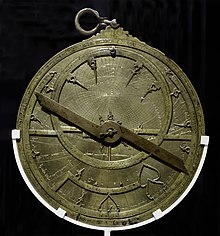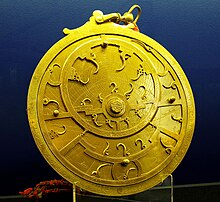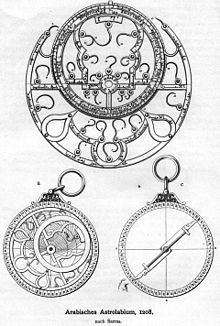Astrolabe
The astrolabe was an ancient astronomical instrument used to determine the position and height of the stars above the sky. The word astrolabe comes etymologically from the Greek ἀστρολάβιον, which can be translated as "star seeker".
The astrolabe was used by navigators, astronomers and scientists in general to locate the stars and observe their movement, to determine the time based on latitude or, vice versa, to find out the latitude knowing the time. It is also used to measure distances by triangulation.
Muslim navigators often used it also to calculate prayer times and locate the direction of Mecca. During the 16th to 18th centuries, it was used as the main instrument for maritime navigation, until the invention of the sextant in 1750.
Typology
Throughout history the astrolabe has been refined and diversified. In this way, we find various types: the planispheric astrolabe designed for the computation and representation of the positions of the stars in a single latitude, the universal astrolabe (valid for all latitudes), the Rojas astrolabe, the Islamic astrolabe, the seaman employed in the location of ships and the quadrant. The astrolabe is an object similar to a compass (also used to guide navigators).
History
Ancient World
It's not really clear who the original inventor was, but an early astrolabe was invented in the Hellenistic civilization by Apollonius of Perga between 220 and 150 BCE. C., often attributed to Hipparco. The astrolabe was a marriage of the planisphere and the diopter, effectively an analog calculator capable of solving several different types of problems in astronomy. Theon of Alexandria (c. 335 – c. 405) wrote a detailed treatise on the astrolabe, and Lewis maintains that Ptolemy used a astrolabe to make the astronomical observations recorded in the Tetrabiblos. Another work by the Greek astronomer and mathematician Ptolemy, such as the Almagest, already describes in the II century His construction. The invention of the flat astrolabe is sometimes wrongly attributed to Theon's daughter Hypatia (c. 350–370; died AD 415), but in fact known to have been in use at least 500 years before Hypatia was born. The misattribution stems from a misinterpretation of a statement in a letter written by Hypatia's student Synesius (c. 373 – c. 414), which mentions that Hypatia had taught her how to build a flat astrolabe, but says nothing about her having invented it herself. We also know that Hipparchus of Nicaea already built astrolabes before Ptolemy and Hypatia.[citation required]
Astrolabes continued to be used in the Greek-speaking world throughout the Byzantine period. Around 550 d. , the Christian philosopher John Philoponus wrote a treatise on the astrolabe in Greek, which is the oldest extant treatise on the instrument. The Mesopotamian bishop Severus Sebokht also wrote a treatise on the astrolabe in the Syriac language at mid-VII century. Sebokht refers to the astrolabe as being made of brass in the introduction to his treatise, indicating that metal astrolabes were known in the Christian East long before they were developed in the Islamic world or the Latin West. The oldest surviving astrolabe was built by the Persian astronomer Nastulus around 927 and It is preserved in the National Museum of Kuwait.
Early Renaissance treatises dealing with scientific problems were based on earlier classical works and often dealt with Ptolemaic doctrines.
By the 8th century it was already widely known in the Islamic world.
Medieval Ages
Astrolabes were further developed in the medieval Islamic world, where Muslim astronomers introduced angular scales into the design, adding circles indicating azimuths on the horizon. It was widely used throughout the Muslim world, primarily as an aid to navigation and as a way to find the Qibla, the direction of Mecca. The 8th century mathematician Muhammad al-Fazari is the first person credited with building the astrolabe in the Islamic world.
The mathematical basis was established by the Muslim astronomer Albatenius in his treatise Kitab az-Zij (c. AD 920), which was translated into Latin by Plato Tiburtinus (De Motu Stellarum). The oldest surviving astrolabe is dated AH 315 (927-28 AD). In the Islamic world, astrolabes were used to find the times of sunrise and fixed stars, to help schedule morning prayers (salat). In the X century, al-Sufi first described more than 1,000 different uses of an astrolabe, in areas as diverse as astronomy, astrology, navigation, topography, timekeeping, prayer, Salat, Qibla, etc.
The spherical astrolabe was a variation of both the astrolabe and the armillary sphere, invented during the Middle Ages by astronomers and inventors from the Islamic world. The earliest description of the spherical astrolabe dates back to Al-Nayrizi (fl. 892-902). In the 12th century, Sharaf al-Dīn al-Tūsī invented the linear astrolabe, sometimes called "al-Tusi staff", which was "a simple wooden rod with graduated markings but without sights. It was fitted with a plumb bob and a double rope for angular measurements and carried a drilled pointer". The geared mechanical astrolabe was invented by Abi Bakr of Isfahan in 1235.
The earliest known metal astrolabe in Western Europe is the Destombes astrolabe, made of brass in the 11th century in Portugal. Metal astrolabes avoided the deformation to which large wooden ones were prone, allowing the construction of larger and therefore more precise instruments. Metal astrolabes were heavier than wooden instruments of the same size, making their use in navigation difficult.
Herman Contractus of Reichenau Abbey, examined the use of the astrolabe in Mensura Astrolai during the 11th century . Pedro de Maricourt wrote a treatise on the construction and use of a universal astrolabe in the last half of the XIII century span> entitled Nova compositio astrolabii particularis. Universal astrolabes can be found in the Oxford Museum of the History of Science. David A. King, historian of Islamic instrumentation, describes the universal astrowolf designed by Ibn al-Sarraj of Aleppo (also known as Ahmad bin Abi Bakr; fl. 1328) as "the most sophisticated astronomical instrument of all medieval and Renaissance times".
The English author Geoffrey Chaucer (c. 1343-1400) compiled for his son A Treatise on the Astrolabe, based mainly on a work by Messahalla or Ibn al-Saffar. The same source was translated by the French astronomer and astrologer Pélerin de Prusse and others. The first printed book on the astrolabe was Composition and Use of the Astrolabe by Christian de Prachatice, also using Messahalla, but relatively original.
In 1370, the first Indian treatise on the astrolabe was written by the Jain astronomer, entitled Yantrarāja.
A simplified astrolabe, known as a balesilha, was used by sailors to obtain an accurate reading of latitude while at sea. The use of the balesilha was promoted by Prince Henry (1394-1460) while he was sailing for Portugal.
Description
The astrolabe is based on the stereographic projection of the celestial sphere. It basically consists of a graduated circumference (motherboard or mater) on whose axis a needle rotates with a crosshair that is aimed at the chosen star. The edge of the mother, or limb, shows a scale graduated in degrees and often also another in hours and minutes. In the upper part, it consists of a ring from which the instrument is suspended in a vertical position to carry out the measurements.
The front part of the instrument, or face of the mater, is slightly concave and two other discs are inserted into it. The internal one, called the eardrum, is a fixed plate engraved with the coordinates of the celestial sphere corresponding to a specific latitude, including the zenith, the horizon, lines of altitude, azimuth, the celestial equator, the ecliptic, and the tropics of Cancer and Capricorn.. The external one, called a spider or net, is rotating and represents a transparent planisphere with the positions of the Sun, the Moon and the brightest stars in the place. On the spider, a needle with a visor, the rule points to the star sought. Directing it to the Sun indicates, on the observer's side, the local time.
The back part of the mother is used to know the height of a tower, the distance to that tower and the symbol of the zodiac that is occupied by the Sun. On top of this part only a needle turns, the alidade with two pinnules or viewers for readings.
Contenido relacionado
(588)
Great Bear
(3992)Wagner


